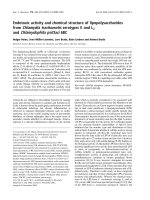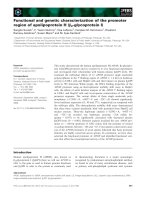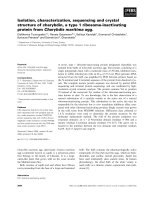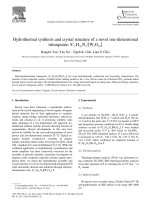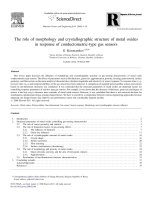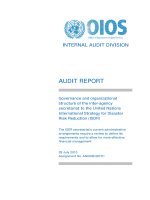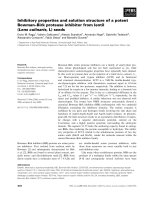Y-chromosome Genotyping and Genetic Structure of Zhuang Populations
Bạn đang xem bản rút gọn của tài liệu. Xem và tải ngay bản đầy đủ của tài liệu tại đây (786.76 KB, 13 trang )
遗 传 学 报
Acta Genetica Sinica, December
2006, 33 (12):1060–1072
ISSN 0379-4172
Y-chromosome Genotyping and Genetic Structure of Zhuang
Populations
CHEN Jing1,2, LI Hui2,3,①, QIN Zhen-Dong2, LIU Wen-Hong2, LIN Wei-Xiong4, YIN Rui-Xing5,
JIN Li2, PAN Shang-Ling1,①
1. Department of Pathophysiology, Guangxi Medical University, Nanning 530021, China;
2. MOE Key Laboratory of Contemporary Anthropology, School of Life Sciences, Fudan University, Shanghai 200433, China;
3. Department of Genetics, School of Medicine, Yale University, New Haven CT 06520-8005, USA;
4. Medical Research Center of Guangxi Medical University, Nanning 530021, China;
5. Institute of Cardiovascular Diseases, the First Affiliated Hospital, Guangxi Medical University, Nanning 530021, China
Abstract: Zhuang, the largest ethnic minority population in China, is one of the descendant groups of the ancient Bai-Yue.
Linguistically, Zhuang languages are grouped into northern and southern dialects. To characterize its genetic structure, 13 East
Asian-specific Y-chromosome biallelic markers and 7 Y-chromosome short tandem repeat (STR) markers were used to infer the
haplogroups of Zhuang populations. Our results showed that O*, O2a, and O1 are the predominant haplogroups in Zhuang.
Frequency distribution and principal component analysis showed that Zhuang was closely related to groups of Bai-Yue origin and
therefore was likely to be the descendant of Bai-Yue. The results of principal component analysis and hierarchical clustering
analysis contradicted the linguistically derived north-south division. Interestingly, a west-east clinal trend of haplotype frequency
changes was observed, which was supported by AMOVA analysis that showed that between-population variance of east-west
division was larger than that of north-south division. O* network suggested that the Hongshuihe branch was the center of Zhuang.
Our study suggests that there are three major components in Zhuang. The O* and O2a constituted the original component; later, O1
was brought into Zhuang, especially eastern Zhuang; and finally, northern Han population brought O3 into the Zhuang populations.
Key words: Y chromosome; Zhuang; internal genetic structure
The nonrecombining portion of the human
Y-chromosome (NRY), which is paternally inherited
and does not undergo recombination during cell division, is prone to form population-specific polymorphisms. In addition, single nucleotide polymorphisms
(SNP) on the Y-chromosome, which has a lower
probability of recurrent mutations and higher reliability, are more group- and area-specific and can record
more accurately human historical migrations and
evolutionary events, a quality because of which they
are rapidly being accepted as one of the most effec-
tive markers for studying human evolution and
origin[1,2]. Using the techniques of denaturing highperformance liquid chromatography (DHPLC) and
single-stranded conformation polymorphism (SSCP),
Underhill et al.[1,2] have investigated several Y-chromosome biallelic markers from populations worldwide in the past and constructed 131 Y-haplogroups
and mapped human evolution genealogy. In Asia, on
the basis of 19 East Asian-specific polymorphic
markers on the Y-chromosome, Su et al.[3,4] established 17 Y-haplogroups, 7 of which were specific to
Received: 2006-02-23; Accepted: 2006-04-07
This work was supported by the Priority Project of the National Natural Science Foundation of China (No. 39993420), the Science
Foundation of Guangxi Province (No.GSN0339041, GSY0542044) and the Genographic Project of National Geography.
① Corresponding authors. LI Hui, E-mail:,Tel:+86-21-6564 2419;
PAN Shang-Ling, E-mail: ,Tel: +86-771-535 8292
CHEN Jing et al.: Y-chromosome Genotyping and Genetic Structure of Zhuang Populations
the East Asian population. By clearly tracing the paternal migration route in East Asia and the Pacific
Region, Su et al. found that the South-Asian group
had more Y-haplogroups compared with the NorthAsian group, indicating that the East Asians originated from the south. On the basis of the data of Su et
al., Li et al.[5,6] studied dozens of ethnic groups in
southern China using these Y-SNP markers and explained their origin, migration, mixture, and evolution,
thereby adding important genetic information and
evidence to the origin of these groups.
With a population of more than 16 million,
Zhuang is China’s largest minority population, with
94% of its population living in the Guangxi autonomous region. The Zhuang language belongs to the
Kam-Tai linguistic family, the Tai-Kadai sublinguistic
family, and the Tai-Sek branch[7], which can be subclassified into Southern and Northern dialects
bounded by Yongjiang River (for details on the distribution of the Zhuang branches, see Fig. 1). It
should be noted that the Bouyei ethnic group in the
Guizhou Province actually belongs to the same popu-
1061
lation as Zhuang, as shown by their language and
culture, and the so-called Shui Hu in the Yunnan
Province, which is completely different from Shui
people in Guizhou, is in fact Bouyei. Therefore, all of
these ethnic groups are considered Zhuang academically. Unfortunately, the Zhuang population does not
have its own written script and has to use Han characters to record events historically, and these records
might be incomplete. On the basis of the few available historical records, Zhuang can be traced back to
the ‘Luo-Yue’ and ‘Xi’Ou’ groups, 2000 years ago[7].
However, the origin of Zhuang might be more complicated than expected because Zhuang might have
experienced complex evolvement and migration and
to a great extent, may have a close relationship with
the origin of Thai and Lao in southeast Asia. At the
same time, Zhuang might be mixed with other surrounding ethnic groups, especially with Han. Therefore, many questions emerge: what is the exact origin
of Zhuang? Is there any genetic evidence to support
their historical migration events? Is it reasonable to
classify Zhuang into South and North groups just
Fig. 1 Distribution of Zhuang branches
North Zhuang dialect group: Guibei, Liujiang, Hongshuihe, Yongbei, Youjiang, Bouyei, Qiubei, Nhang, Tai-Mène. South Zhuang
dialect group: Yongnan, Tày, Man-Caolan, Nung, YanGuang, WenMa, E (Wuse), Tsün-Lao.
1062
遗传学报
based on dialects without any genetic indication? Can
the genetic nature of Zhuang provide any information
for the study of the origin and migration of the surrounding populations? Furthermore, when the early
east-Asian population moved northward via the
Guangxi region, were there any original genetic materials retained in the native Zhuangs?
Very few published reports are available about
Zhuang’s paternal genetic structure, and most of these
have mainly focused on some of its special branches.
In this study, the Y-haplogroups were typed for eight
branches of the Zhuang population with 13 biallelic
markers and 7 Y-chromosome short tandem repeats
(STR), and for every haplogroup, the frequency was
calculated, the principal component analysis was carried out, and the heredity framework was drawn. The
authors of this study hope to determine Zhuang’s inherited structure at a genetic level and to provide genetic data for further studies on Zhuang’s linguistics,
origin, transformation, and admixing with other ethnic groups.
Acta Genetica Sinica
Vol.33 No.12 2006
Table 1 Sample distribution of eight branches of Zhuang
from Guangxi province
Branches
Abbreviation
Size
Yongbei
YB
23
Youjiang
YJ
5
Guibian/Bouyei
GB
4
Hongshuihe
HSH
39
Guibei
GN
21
Yongnan
YN
19
Zuojiang/Tày
ZJ
15
Dejing/Nung
DJ
3
Total
129
SNPs without length changes, i.e., substitution or
transversion, PCR-RFLP (Restriction Fragment
Length Polymorphism) was used[4,6,8 10]. The Y-hap-
logroup of every subject was determined by the integrated analysis of the Y-SNP typing results of the two
typing methods.
For PCR, a primers mix was used, which contained M175, 0.04 μL; M121, 0.03 μL; M134, 0.03
μL; M117, 0.06 μL; M111, 0.08 μL; and M15, 0.02
1
1. 1
Materials and Methods
Sample collection and DNA extraction
A total of 129 blood samples were collected
from eight representative Zhuang-living areas in the
Guangxi Province, each representing eight Zhuang
branches. DNA was extracted from white blood cells
using the traditional phenol-chloroform method[8].
Table 1 shows the details on the different branches
and the sample sizes. All individuals who were
Zhuang for more than three generations and were
unrelated healthy males were asked to sign informed
consent at the time of recruitment.
1. 2
Y-chromosome biallelic typing
Two strategies were introduced to type Y-SNP.
For SNPs with length variation, i.e., deletion or insertion, fluorescence PCR (primer information shown in
Table 2) was used, the obtained product was electrophoresed on a 3100 genetic analyzer (ABI company,
USA) to determine the individual’s genotype. For
μL. Each PCR reaction (volume 5 μL) included
KodDash polymerase (TOYOBA) 0.5 U, 0.26 μL
Primer Mix, 10 ng of genomic DNA, and buffer. The
PCR conditions were as follows: 30 cycles of 98℃
for 10 s, 55℃ for 2 s, 74℃ for 2 s, and a final extension at 4℃.
To test the degree of variation among different
branches, Y-STR was typed using the same method
that was used for typing Y-SNP. Information on
Y-STR primers is also shown in Table 2. The volume
of each PCR system was 5 μL, containing KodDash
polymerase, 0.05 μL; 10× buffer, 0.5 μL; dNTP (2.5
mmol/L each), 0.4 μL; genomic DNA, 10 ng; mixture
of primers, 0.4 μL. Usually, PCR reaction was carried
out in two panels. Panel 1 included primer pairs
DYS389, 0.05 μL × 2 (forward and reverse); DYS390,
0.07 μL × 2; DYS391, 0.08 μL × 2; with a total volume of 0.4 μL. Panel 2 included DYS388, 0.05 μL ×
2; DYS392, 0.07 μL × 2; DYS393, 0.02 μL × 2;
DYS19, 0.06 μL × 2.
CHEN Jing et al.: Y-chromosome Genotyping and Genetic Structure of Zhuang Populations
Table 2
1063
Y-Chromosome SNP, STR fluorescence primers
Locus
M121
M117
M175
M134
M15
M111
DYS388
DYS389
DYS390
DYS391
DYS392
DYS393
DYS394
Primer sequence (5′→3′)
F:ACAAAGACCTGGACAGATTAC
R:CCCTTAAAAACAGCATGATA
F:GTACGAAGAAAATCAAGGCTATTA
R:TTGGGTAGAAAAACTGCAAGTAG
F:TTGAGCAAGAAAAATAGTACCCA
R:TTCAGTTAGCCTTGATTGACTGT
F:AGAATCATCAAACCCAGAAGG
R:TCTTTGGCTTCTCTTTGAACAG
F:ACAAATCCTGAACAATCGC
R:GTCTGGGAAGAGTAGAGAAAAG
F:TAACATAAACAGTATGCCAAA
R:TGCCCTAAAGTTAATACCAG
F:GTGAGTTAGCCGTTTAGCGA
R:CAGATCGCAACCACTGCG
F:CCAACTCTCATCTGTATTATCTATG
R:TCTTATCTCCACCCACCAGA
F:TATATTTTACACATTTTTGGGCC
R:TGACAGTAAAATGAACACATTGC
F:CTATTCATTCAATCATACACCCA
R:GATTCTTTGTGGTGGGTCTG
F:TCATTAATCTAGCTTTTAAAAACAA
R:AGACCCAGTTGATGCAATGT
F:GTGGTCTTCTACTTGTGTCAATAC
R:AACTCAAGTCCAAAAAATGAGG
F:CTACTGAGTTTCTGTTATAGT
R:ATGGCATGTAGTGAGGACA
Fluorescence
Product size (bp)
Wide type
Mutant type
FAM
123
118
FAM
317
313
FAM
226
221
NED
232
231
FAM
151
142
HEX
197
195
FAM
FAM
NED
HEX
NED
HEX
HEX
F: forward; R:reverse.
1. 3
Statistical analysis
The Y-haplogroup of every individual was defined based on the experimental results of the authors
of this study and the NRY haplogroup tree of
East-Asia shown in reference [11].
In practice, to ensure that an effective genetic
sample size has been obtained, for every branch,
other published data such as those on Bouyeis,
Zhuangs, Suis in Yunnan[12], Bouyeis in Guizhou [13],
and unpublished data (Fudan University, data not
shown) such as those on Tianlin Zhuangs, Shangsi
Zhuangs, Wuse Zhuangs, and Man-Caolan Zhuangs
in Guangxi were added to the relevant Zhuang
branches.
Hierarchical clustering analysis was carried out
to show the genetic distance (affinity) among
Guangxi Zhuang branches, using SPSS13.0 by calculating the frequency of different haplogroups in every
branch. The phylogeny relationship among Zhuang
branches was carried out by combining analysis of
hierarchical clustering, principal component analysis,
and association analysis to determine the association
between phylogeny and Y-chromosome haplogroups;
this was then observed using the gradient distribution
chart which was drawn using Surfer7.0 software for
every principal component according to its geographic distribution, in which principal component
value served as the height values.
Variances among and within populations resulting from Y-haplotype frequencies of different
branches were calculated using AMOVA (Analysis of
MOlecular VAriance framework) in Arlequin1.1
software to further elucidate the phylogeny of different Zhuang branches. Finally, Zhuang’s genetic
framework was drawn using the network 11.0 software with the same Y-STR haplogroups of different
branches to show the detailed difference and association among Zhuang branches.
1064
2
遗传学报
Results
2. 1
Distribution of NRY haplogroups in Zhuang
branches
The haplogroup frequencies of different Zhuang
branches stemming from the typing results of Y-SNP
were calculated. As shown in Table 3, Zhuang’s
Y-haplogroups mainly cluster around O*, O1, O2a,
and O3, the four most common haplogroups in East
Asia. Haplogroup O* is the most frequent, followed
by O2a and O1, showing that Zhuang is a typical
southern group in East Asia and possesses more ancient Y-haplogroups. Interestingly, O3, O3e, and
O3e1, the characteristic haplogroups for East Asian
northern group were also frequently found in
Zhuangs, showing a common gene communication
between the two populations.
2. 2
Principal component analysis
Principal component analysis was carried out
using SPSS 13.0 software, and the principal component dot plot of Y-SNP frequencies was drawn (Fig. 2)
according to Y-SNP typing results of different
branches, as obtained by the authors of this study, and
additional data of Yunnan Bouyeis, Zhuangs, Suis,
Guangxi Tianlin, Shuangsi, Wuse, Man-Caolan
Zhuangs, and Guizhou Bouyeis. In this analysis,
Tianlin was merged with the Youjiang branch,
Shangsi was merged with the Zuojiang branch, and
Table 3
Acta Genetica Sinica
Vol.33 No.12 2006
Bouyei with the Guibian branch.
The result of principal component analysis
showed that the cumulative contribution of principal
component 1 (pc1) and component 2 (pc2) accounted
for 82.5% of the total difference. It is obvious from
Fig. 2 that 12 Zhuang branches and other correlated
groups mainly gathered into two bigger groups.
Hongshuihe, Guibei, Yongbei, Yongnan, and ManCaolan were located in the upper part of the principal
components plot and constituted the first group,
whereas Guibian, Zuojiang, Youjiang branch, Yunnan
Zhuang, and Yunnan Bouyei clustered in the lower
part of the chart, and constituted the second group.
Yunnan Shui Hu seemed to be isolated from all
branches, but was somewhat closer to the second
group on pc2. As shown in Fig. 2, it is the pc2 that
separated these branches into two groups. Considering the geographic location of each branch, it was
observed that the difference between the two groups
was, genetically, an east–west rather than a southnorth profile, contradicting the traditional south-north
grouping of Zhuangs by linguistic factors.
Using the values of pc1 and pc2 as height values,
the principal component gradient distribution diagram
was drawn in the same manner as drawing relief map
with contours according to the geographic location of
each Zhuang branch (Fig. 3). In the relief map of pc1,
it was observed that the peak value was near the
Guangxi-Vietnam border, which gradually changed
Y-SNP haplogroup frequencies of branches of Zhuang
Branches
Size
C
D
D1a
F*
YB
23
8.70
YJ
5
Tianlin
22
GB
4
HSH
39
2.56
GN
21
4.76
YN
19
ZJ
15
Shangsi
15
13.33
DJ
3
100.00
4.35
K*
O
O1
4.35
21.704
17.39
40.00
20.00
5.13
4.76
5.26
6.67
O2a*
O2a1
O3
8.70
21.74
8.70
O3a
O3e*
O3e1
4.35
4.35
20.00
20.00
13.64
4.55
25.00
25.00
25.00
5.13
23.08
10.26
5.13
7.69
20.51
5.13
4.76
38.10
4.76
4.76
4.76
14.29
14.29
5.26
15.79
10.53
10.53
10.53
31.58
33.33
72.73
4.55
25.00
40.00
20.00
4.55
60.00
20.00
6.67
5.26
5.26
15.38
CHEN Jing et al.: Y-chromosome Genotyping and Genetic Structure of Zhuang Populations
Fig. 2
1065
The principal components plot of Y-SNP frequencies of Zhuang populations
Fig. 3 Geographic map of Y-SNP principal components of Zhuang populations
X coordinate: longitude; Y coordinate: latitude. The geographic map of Y-SNP principal components of Zhuang branches was
drawn using principal component value as contour, wherein, the lower the value, the darker of the color. For pc1 (left), the peak
value was near the Guangxi-Vietnam border, which gradually changed north-eastward and north-westward. The peak value of pc2
that classifies Zhuang branches into two main groups appeared in the east Hongshuihe basin (right), exhibiting an east-to-west gradient. It is quite clear that contour lines run along rivers, indicating that native Zhuangs migrated upstream along rivers in Guangxi
in early times.
1066
遗传学报
Acta Genetica Sinica
Vol.33 No.12 2006
served. Theoretically, the more positive correlated
study, it was observed that pc1 was positively associated with O2a (r = 0.69, p = 0.02) and that the values
of pcl were all positive. Therefore, the meaning of
pc1 underscores the positive correlation of Zhuang
branches and Yunnan Shui Hu with O2a, showing
that these ethnic groups are all typical southern
groups of East-Asian population, a conclusion that is
consistent with the historical records of Zhuang’s
Baiyue origin.
For pc2, the number of positively correlated
haplogroups was almost the same as that of the negative ones, with an opposite trend being found between
O* and O2a: haplogroup O* was positively but O2a
was negatively associated with pc2. Both pc2 and
haplogroup O* were clearly related to longitude, implying that haplogroup O* was the main component
of pc2, i.e., it is O* that separates the Zhuang
branches into two main groups. With the westward
movement of haplogroup O*, O2a retreated in the
same direction. This process agrees with the lower
frequency of O2a in east Zhuang branches.
No significant correlation was found between
other haplogroups and the two principal components.
haplogroup a principal component has, the more dis-
2. 4
north-eastward and north-westward. This might be a
clue to the spreading of the East Asian population in
ancient Guangxi when it first entered East Asia. Because pc2 classifies Zhuang branches into two main
groups, its significance might be more definite. The
peak value of pc2 appeared in the east Hongshuihe
basin, exhibiting an east-to-west gradient. In addition,
a higher value of pc2 was seen in northwest Guangxi
bordering the Yunnan Province. This might be influenced by data of the Yunnan Bouyeis. Furthermore,
from Fig. 3 it is quite clear that contour lines run
along rivers, indicating that native Zhuangs migrated
upstream along rivers in Guangxi in early times.
2. 3
Correlation analysis
To understand the meaning of each principal
component, correlation analysis was carried out to
seek the origin of each principal component. Each
principal component was sorted out after calculating
the correlation coefficient for every haplogroup such
that the positively and negatively correlated haplogroups of the principal components could be ob-
tinct is its genetic structure, and the more practical
meaning it has. For more detail, see Figs. 4 and 5.
Apparently, the structure of pc2 is clearer than
that of pc1, after comparing the correlation coefficient values of the two principal components. There
were many contradictions in the variables among
positively correlated haplogroups in pc1, whereas in
pc2, most positively associated variables fell within
the positive correlation area. Moreover, pc2 was
markedly positively correlated with longitude, showing that pc2 was more significant than pc1.
Further analysis of pc1 showed that the number
of positive correlated haplogroups, despite their weak
correlations, was bigger than that of the negative
groups. This is attributed mainly to the difference
between O2a and O3e, where O2a was a southern
aboriginal haplogroup in the East Asian population
and O3e was probably a northern haplogroup. In this
Hierarchical clustering analysis
To further elucidate the relationship among
Guangxi Zhuang branches, hierarchical clustering
analysis was carried out with average linkage (between groups) in SPSS 13.0 software and the results
are shown in Fig. 6, in which Mien and Yi are the
foreign groups. It is clear that the center of all Zhuang
branches emerges in the Hongshuihe area, evolving
gradually toward Yongbei, Yongnan, and Guibian
along the Hongshuihe river, then toward Guibei and
Man-Caolan, and finally toward Zuojing, Youjiang,
and Yunnan, providing strong evidence once again
that the difference among Zhuang branches is fundamentally east-west and not south- north, as traditionally believed. Intriguingly, Wuse Zhuangs living in
Yongle, Rongshui, a northwest county in Guangxi,
are genetically close to the remote Zuojiang Zhuangs
who live in southwestern Guangxi, implying a special
moving event in ancient times.
CHEN Jing et al.: Y-chromosome Genotyping and Genetic Structure of Zhuang Populations
1067
Fig. 4 Correlations among principal components, Y-SNP frequencies, longitude, and latitude of Zhuang branches
Principal components were ranked after their correlation coefficient for relevant haplogroup were calculated to estimate the positively and negatively correlated haplogroups of the principal components. Each correlation coefficient was marked with relevant
color according to its value. There were many contradictions in the variables among positively correlated haplogroups in pc1 (left),
whereas in pc2, most positively associated variables fell within the positive correlation area (right).
Fig. 5 Correlations and statistical significance among principal components, Y-SNP frequencies, longitude, and latitude of
Zhuang branches
r: correlation coefficient; P: probability value; long.: longitude; lat.: latitude. Chromatism staff gauge shows different p values. pc1
was positively associated with O2a, a typical south aboriginal haplogroup in East Asian population, underscoring the positive correlation of Zhuang branches and Yunnan Shui Hu with O2a. For pc2, the number of positively correlated haplogroups was almost
the same as that of the negative ones, with an opposite trend being observed between O* and O2a, in which haplogroup O* was
positively but O2a was negatively associated with pc2.
1068
遗传学报
Acta Genetica Sinica
Vol.33 No.12 2006
within populations was quite the opposite, further
suggesting that the classification of east and west
Zhuang is more reasonable than that of the southnorth grouping if these groups need to be distinguished. However, because the east-west difference is
graded due to Zhuang population migration, it is very
difficult to differentiate Zhuangs into two distinct
groups genetically.
2. 6
Fig. 6 Dendrogram of Y-SNP of Zhuang branches
Yi and Mien, two non-Baiyue populations living in southwest
China, were introduced to illustrate the cluster of Zhuang and
its relationship with surrounding non-Baiyue groups. This
dendrogram showed that the ancestor of Zhuang gathered in
Hongshuihe area first, then spread toward Yongjiang and Youjiang basin, and the surrounding area. Genetically, Zhuang was
much far away from Yi and Mien.
2. 5
AMOVA analysis
Linguists divide the Zhuangs into the southern
group and northern group, according to their dialects.
If this classification has a genetic basis, the variance
among populations should be greater, whereas the
variance within populations should be smaller in the
molecular variance framework analysis. As suggested
by the pc2 results, the AMOVA results were compared between the southern and northern groups and
between the eastern and western groups (Table 4).
However, no differences were observed, as once anticipated. Instead, the variance among populations of
the eastern-western groups was far greater than that
of the northern-southern groups, whereas the variance
Table 4
Network analysis of Y-chromosome STR
haplogroup of Guangxi Zhuang branches
The combination of several short tandem repeats
(STR) in NRY comprises another type of Y-chromosome haplogroup, which reflects minute genetic
variances in different populations with the same
Y-SNP. This differs from Y-SNP haplogroup, which
can only be roughly used in the classification of systematic phylogeny. After sorting out different Zhuang
branches on the basis of Y-SNP information, the genetic network was drawn using Network 11.0 with
Y-STR data from individuals of all branches to show
the relationship and differences between branches
with the same Y-SNP haplogroups.
As shown in Fig. 7, the information of STR
network of haplogroup O* is more abundant due to
its higher frequency in all Zhuang branches. Nine
individuals from Hongshuihe branch with haplogroup
O* had 8 Y-STRs, the highest Y-STRs frequency of
all, three of which were shared by Guibian, Guibei,
and Yongbei individuals. In addition, Hongshuihe
Zhuangs were closely related with individuals from
other haplogroups, especially Yongbei and Guibei
individuals, establishing its central position in all
Results of AMOVA of northern-southern group and eastern-western group of Zhuang branches
Eastern–western
Northern-southern
Eastern: HSH, YN, YB, CL, GN
Northern: YB, YJ, HB, HSH, GB
Western: ZJ, YJ, GB, E, DJ
Southern: YN, ZJ, DJ, CL, E
Among populations
17.851
3.461
Within populations
18.539
32.929
Groups
CHEN Jing et al.: Y-chromosome Genotyping and Genetic Structure of Zhuang Populations
1069
Fig. 7 STR network of haplogroups O*, O1, O2a, and O3* of Zhuang branches
In the network of haplogroups O* and O1, Hongshuihe branch had more STR haplogroup polymorphisms and was closely related
with others, especially Yongbei and Guibei individuals, establishing its central position in all Zhuang branches. In the O2a network,
Zuojiang branch had more Y-STRs. In the O3* network, no shared STR haplogroup was seen.
Zhuang branches. Only one Guibei individual shared
the same Y-STR haplogroups with that of Hongshuihe
although Guibei branch also had 8 STR haplogroups
that were distributed at the edge of the O* haplogroup
network. More linkage was also found among Zuojiang, Youjiang, and Dejing branches, which, as a
closed group, was more isolated from others. Taken
together, all these findings verify and agree with results from the principal component analysis and the
above-mentioned clustering analysis.
Likewise, in the O1 network, Hongshuihe
branch had more STR haplogroup polymorphisms
than others and occupied the center of the framework.
However, it failed to maintain its leading position in
O2a and gave way to Zuojiang branch as a result of
fewer individuals carrying the O2a haplogroup. There
was no shared STR haplogroup or any remarkable
difference among branches in the O3* network. One
possible explanation is that O3* is not the dominant
and characteristic haplogroup in Zhuangs.
1070
3
3. 1
遗传学报
Discussion
The origin of Zhuangs
Historical records, linguistic studies, and ethnology investigations, all suggest that Zhuang might
have been derived from Luoyue and Xi’ou division of
ancient Baiyue. In this study, O*, O2a, and O1, the
characteristic Y-SNP haplogroups of Baiyues, were
found to be frequently present in Zhuangs. In addition,
principal component analysis confirmed that Zhuangs
clustered with Yuannan Shuihu and Bouyei, proven
typical descendants of Baiyue. Therefore, all these
studies strongly indicate that Zhuang stemmed from
the ancient Baiyue group, which is consistent with
historical records and cultural anthropological results[10,12,14].
3. 2 Genetic structure of northern Zhuang dialect group and southern Zhuang dialect
group
Without a written language, Zhuang’s important
historic events were less reliably documented and
were passed to the next generation by limited oral
folklores and by a few recent references written by
Han Chinese. Coupled with several large-scale population movement and chaos brought on by wars, it is
hard to explore the development, differentiation,
communication, and evolvement of Zhuang’s inner
branches using historical records. Therefore, Zhuangs
can only be divided into a northern dialect group and
a southern dialect group, according to their approximate difference in spoken languages.
No striking difference in the genetic structure of
the two dialect groups was found, which was an unexpected result. The principal component analyses
showed that, either on pc1 or pc2, there was no clustering in both branches within the southern dialect
group or branches belonging to the northern dialect
group. The geographic map and clustering analysis of
principal component did not present a south-to-north
gradual change and gathering. In other words, the
linguistic definition of south Zhuang and north
Zhuang lacks relevant genetic supports and both
Acta Genetica Sinica
Vol.33 No.12 2006
groups are in fact a genetically homogeneous population. Instead, Zhuangs exhibit, if any, a Hongshuihe-centered, east-to-west gradually diffusing
process in their heredity structure. Indeed, according
to legend, the name of ‘Zhuang’ ethnic group
stemmed from ‘Yangke river’, the ancient name of
Hongshuihe river, and this may not be a coincidence.
Principal component analysis showed that
Zhuang was divided into eastern and western subgroups according to their geographical distribution.
However, clustering analysis suggested that Guangxi
Zhuangs gradually expanded westward from the
Hongshuihe branch. In the STR haplogroup network
of Zhuang branches, especially in the network of the
O* haplogroup, Hongshuihe branch was also in the
center. Zuojiang, Youjiang, and Dejing branches
within the territory of the western subgroup were
more close to each other in terms of genetic framework and were a little away from the eastern subgroup.
3. 3
Genetic levels of Zhuangs
Table 2 shows the Y-SNP haplogroup frequencies of Zhuang branches, from which it can be seen
that two older haplogroups, O* and O2a, were more
frequently present, suggesting that these two haplogroups might be the original components of
Zhuangs and remained as heredity markers from early
inhabitants when they entered Guangxi and spread in
the east Asian continent. In pc1 geographic map,
multiple centers could be seen and expansions in the
south-to-northeast and south-to-southwest directions
were observed. Furthermore, pc1 was proved in correlation analysis to be positively associated with haplogroup O2a, which might be more than 10 000 years
old according to the STR age estimate[15], suggesting
that the ancestors of Zhuangs had carried marker O2a
when they first entered into Guangxi area.
More interestingly, haplogroup O* was estimated to be around 200 00 years old, suggesting that
it might be another primary component. It is possible
that the early East Asian population went straight to
Hongshuihe area first when they arrived in east Asian
CHEN Jing et al.: Y-chromosome Genotyping and Genetic Structure of Zhuang Populations
continent and then migrated and developed around in
the region now called Guangxi.
Finally, the inner structure of O1 haplogroup
showed that some components of Zhuang scattered
from east to west. This is within 100 00 years and is
possibly caused by the mixture of Xi’Ou with LuoYue, becoming the second genetic level of Zhuangs.
Historically, several massive settlements of soldiers and officials into Guangxi by governmental
policies and a couple of big southward movements of
Zhuangs might have contributed to the mixture of
Zhuang’s gene pool. In the results of this study, O3, a
characteristic haplogroup in north group in East Asian
population, was also considerably higher in Zhuangs.
Unfortunately, either subgroups or center for haplogroup O3 was not obtained, indicating that this
haplogroup is a foreign component and can be traced
to the intermixing of northern Chinese and Guangxi
locals, which is also consistent with historical records.
References:
[1] Underhill P A, Shen P, Lin A A, Jin L, Passarino G,
Yang W H, Kauffman E, Bonné-Tamir B, Bertranpetit J,
Francalacci P, Ibrahim M, Jenkins T, Kidd K, Mehdi S
Q, Seielstad M T, Wells R S, Piazza A, Davis R W,
Feldman M W, Cavalli-Sforza L L, Oefner P. Y chromosome sequence variation and the history of human
populations. Nat Genet, 2000, 26: 358-361.
[2] Underhill P A, Passarino G, Lin A A, Shen P, Mirazon
Lahr M, Foley R A, Oefner P J, Cavalli-Sforza L L. The
phylogeography of Y chromosome binary haplotypes
and the origins of modern human populations. Annals of
Human Genetics, 2001, 65: 43-62.
[3] Jin Li, Su Bing. Natives or immigrants: modern human
origin in East Asia. Nature Genetics Reviews,2000,1:
126-132.
[4] Su B, Xiao J, Underhill P, Deka R, Zhang W, Akey J,
Huang W, Shen D, Lu D, Luo J, Chu J, Tan J, Shen P,
Davis R, Cavalli-Sforza L L, Chakraborty R, Xiong M,
Du R, Oefner P, Chen Z, Jin L. Y chromosome evidence
for a northward migration of modern humans in East
Asia during the last Ice Age. Am J Hum Genet, 1999, 65:
1718-1724.
1071
[5] Li H, Pan W, Wen B, Yang N, Jin J, Jin L, Lu D. Origin
of Hakka and Hakkanese: a genetics analysis. Acta Genetica Sinica, 2003, 30(8): 7-14 (in Chinese with an
English abstract).
[6] Li H, Yang N, Huang X, Chen L, Jin J, Jin L, Lu D. A
genetic and anthropological study of Beigao population
and its implication in identification of its ethnicity. J
Chinese University of Nationalities, 2002, 11: 108-116.
[7] Zhang S Z. The general history of Zhuang. Beijing:
Minzu Press, 1997 (in Chinese).
[8] Li H, Hou J, Yang N. A molecular anthropologic study
on the origin of Liujia people in Guangxi. Journal of
Guangxi University for Nationalities, 2002, 24: 38-43
(in Chinese with an English abstract).
[9] Sambrook J, Fritsch E F, Maniantis T (Translated By Jin
Dong-Yan, Li Meng-Feng). Molecular Cloning: A Laboratory Manual. 2nd ed. Beijing: Science Press, 1996,
463-469 (in Chinese).
[10] Wen B, Li H, Lu D, Song X, Zhang F, He Y, Li F, Gao
Y, Mao X, Zhang L, Qian J, Tan J, Jin J, Huang W,
Deka R, Su B, Chakraborty R, Jin L. Genetic evidence
supports demic diffusion of Han culture. Nature, 2004,
431: 302-305.
[11] The Y Chromosome Consortium. A nomenclature system for the tree of human Y-chromosomal binary haplogroups. Genome Res, 2002, 12: 339-348.
[12] Dong Yong-Li, Yang Zhi-Li, Shi Hong, Gao Lu, Lu Jing,
Cheng Bao-Wen, Li Kai-Yuan, Zan Rui-Guang, Xiao
Chun-Jie. Principal component analysis of Y- chromosome haplotype distribution in 18 ethnic groups in yunnan province. Acta Genetica Sinica, 2004, 31(10): 10301036 (in Chinese with an English abstract).
[13] Li Y N, Zuo L, Wen B, Ke Y H, Huang W, Jin L. Origins
and migrations of Bouyei people in China--insights
from Y chromosome and mitochondrion. Acta Genetica
Sinica, 2002, 29(3): 196-200 (in Chinese with an
English abstract).
[14] Gao Lu, Dong Yong-Li, Hao Zhao-Jing, Wang Ou,
Yang Zhi-Li, Su Yan-Hua, Zheng Bing-Rong, Zan
Rui-Guang, Xiao Chun-Jie. Genetic polymorphism of
mitochondrial dan in coding region in 16 Ethnic populations of Yunnan. Acta Genetica Sinica, 2005, 32(2):
118-123 (in Chinese with an English abstract).
[15] LI H. On dividing of Baiyue people’s hereditary frame.
Study of Ethnics in Guangxi, 2002. 70(4): 26-31 (in Chinese with an English abstract).
1072
遗传学报
Acta Genetica Sinica
Vol.33 No.12 2006
壮族 Y 染色体分型及其内部遗传结构
陈 晶1,2,李 辉2,3,覃振东2,刘文泓2,林伟雄4,尹瑞兴5,金 力2,潘尚领1
1. 广西医科大学病理生理教研室,南宁 530021;
2. 复旦大学生命科学院教育部现代人类学重点实验室,上海 200433;
3. 耶鲁大学医学院遗传系,新港,康奈狄格州 06520-8005;
4. 广西医科大学医学实验中心,南宁 530021;
5. 广西医科大学第一附属医院老年心血管病研究所,南宁 530021
摘 要: 壮族是中国最大的少数民族,与东南亚的泰老族群关系密切,在东亚人群的遗传结构研究中地位非常特殊。本研究
调查了壮族各个支系的 Y 染色体多样性,通过主成分分析、聚类分析和分子方差分析,揭示壮族的内部父系遗传结构。结
果发现,壮族的主要 Y 染色体单倍群为 O*, O2a, O1。传统的对壮族按方言分为南北二组的分类方法在遗传上并没有依据,
壮族支系体现出从东往西的梯度变化过程。这说明壮族的结构中有几个层次,最早的成分普遍出现在各个支系中,第二层
是由东部来的百越核心成分,第三层是北方来的汉族成分。壮族内部遗传结构的分析将有助于对东亚人群的南来起源的研
究。
关键词: Y-染色体;壮族;内部遗传结构
作者简介: 陈晶(1980-)女,硕士研究生,研究方向:分子人类学。E-mail:


